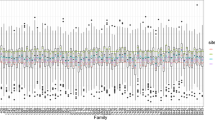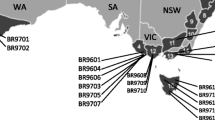Abstract
Implications of genotype × environment interaction resulting from site differences in expression of genetic variation (LoE interaction) were explored for some plausible scenarios for breeding radiata pine. Expected genetic gains were modelled in a Smith-Hazel selection index. Two sites were modelled, addressing two sets of three traits at each site, to create 6 × 6 genetic and phenotypic covariance matrices based on typical heritabilities and between-trait correlations as well as rank-change (RC) interaction. Two of the traits, which behaved like stem volume production and disease resistance respectively, featured in all scenarios, with disease being expressed and influencing volume at only one site. Two alternatives for the third trait behaved like wood density and stem straightness respectively, two levels of genetic trade-off between volume and density being addressed. The impact of LoE interaction was modelled by assigning either zero or non-zero economic weight to a trait at one site. Comparisons of expected genetic gains indicated how substantial economic gains can depend on appropriate recognition, in selection for deployment, of LoE interaction. Expected economic gains from selection for both sites jointly were generally little less than those from selection for individual sites.
Similar content being viewed by others
Notes
For this, the term “scale interaction” is often used, but we reserve that term for cases where data transformation (e.g. log or square root) makes the interaction disappear statistically.
References
Bowman JC (1972) Genotype × environment interactions. Ann Génét Sél Anim 4(1):117–123
Burdon RD (1971) Clonal repeatabilities and clone-site interaction in Pinus radiata. Silvae Genet 20:33–39
Burdon RD (1977) Genetic correlation as a concept for studying genotype-environment interaction in forest tree breeding. Silvae Genet 16:168–175
Burdon RD (1979) Generalisation of multi-trait selection indices using information from several sites. N Z J For Sci 9:145–152
Burdon RD (1990) Implications of non-linear economic weights for breeding. Theor Appl Genet 79:65–71
Burdon RD (2001) Pinus radiata. In: Last FT (ed) Ecosystems of the world, vol 19, tree crop ecosystems. Elsevier, Amsterdam, pp 99–161
Burdon RD (2010) Wood properties and genetic improvement of radiata pine. N Z J For 55(2):22–27
Burdon RD, Miller JT (1992) Introduced forest trees in New Zealand: recognition, role and seed source. Radiata pine (Pinus radiata D.Don). Rotorua New Zealand Forest Research Institute, Bull 124/12
Burdon RD, Bannister MH, Low CB (1992) Genetic survey of Pinus radiata. 4: between-trait and age-age correlations for growth rate, morphology, and disease resistance. N Z J For Sci 22:211−227
Burdon RD, Li Y, Suontama M, Dungey HS (2017) Genotype × site × silviculture interactions in radiata pine: knowledge, working hypotheses and pointers for research. N Z J For Sci 47(6). https://doi.org/10.1186/s40490-017-0087-1
Cotterill PP, Dean CA (1990) Successful tree breeding with index selection. CSIRO Publications, East Melbourne
Dickerson GE (1962) Implications of genetic-environmental interaction in animal breeding. Anim Sci 4:47–64
Evison DC, Apiolaza LA (2015) Incorporating economic weights into radiata pine breeding. Can J For Res 45:133–140
Huang W, Mackay TFC (2016) The genetic architecture of quantitative traits cannot be inferred from variance component analysis. PLoS Genet 12(11):e1006421. https://doi.org/10.1371/journal.pgen.1006421
Isik F (2014) Genomic selection in forest tree breeding: the concept and an outlook to the future. New For 45:379–401
Johnson GR, Burdon RD (1990) Family-site interaction in Pinus radiata: implications for progeny testing and regionalised breeding in New Zealand. Silvae Genet 39:55–62
King JN, Burdon RD (1991) Time trends in inheritance and projected efficiencies of early selection in a large, 17-year-old progeny test of Pinus radiata. Can J For Res 21:1200–1207
Li Y, Suontama M, Burdon RD, Dungey HS (2017) Genotype by environment interactions in forest tree breeding: a review of methodology and perspectives on research and application. Tree Genet Genomes 13:60 18 p
Muir W, Nyquist WE, Xu S (1992) Alternative partitioning of the genotype-by-environment interaction. Theor Appl Genet 84:193–200
Shelbourne CJA, Low CB (1980) Multi-trait selection and associated genetic gains of Pinus radiata progenies at five sites. N Z J For Sci 10:307–324
White TL, Adams WT, Neale DB (2007) Forest genetics. CABI Publishing, Wallingford
Wu HX, Ivković M, Gapare WJ, Matheson AC, Baltunis BS, Powell MB, McRae TA (2008) Breeding for wood quality and profit in Pinus radiata: a review of genetic parameter estimates and implications for breeding and deployment. N Z J For Sci 38:56–87
Acknowledgements
We thank Greg Dutkowski for helpful comments on a draft, and Tim Mullin for helpful comments and suggestions for the presentation. RDB had use of Scion office facilities, and YL’s time was covered by Scion’s Forest Genetics core funding allocation.
Author information
Authors and Affiliations
Corresponding author
Ethics declarations
Competing interests
The authors declare that they have no competing interests.
Additional information
Communicated by J. Beaulieu
Publisher’s Note
Springer Nature remains neutral with regard to jurisdictional claims in published maps and institutional affiliations.
Electronic supplementary material
ESM 1
(DOCX 20.1 kb)
Rights and permissions
About this article
Cite this article
Burdon, R.D., Li, Y. Genotype-environment interaction involving site differences in expression of genetic variation along with genotypic rank changes: simulations of economic significance. Tree Genetics & Genomes 15, 2 (2019). https://doi.org/10.1007/s11295-018-1308-3
Received:
Revised:
Accepted:
Published:
DOI: https://doi.org/10.1007/s11295-018-1308-3




